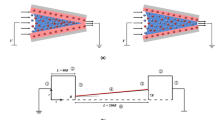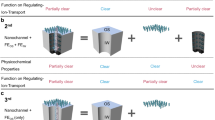Abstract
Recent advances in nanofluidics have allowed the exploration of ion transport down to molecular-scale confinement, yet artificial porins are still far from reaching the advanced functionalities of biological ion machinery. Achieving single ion transport that is tunable by an external gate—the ionic analogue of electronic Coulomb blockade—would open new avenues in this quest. However, an understanding of ionic Coulomb blockade beyond the electronic analogy is still lacking. Here, we show that the many-body dynamics of ions in a charged nanochannel result in quantized and strongly nonlinear ionic transport, in full agreement with molecular simulations. We find that ionic Coulomb blockade occurs when, upon sufficient confinement, oppositely charged ions form ‘Bjerrum pairs’, and the conduction proceeds through a mechanism reminiscent of Onsager’s Wien effect. Our findings open the way to novel nanofluidic functionalities, such as an ion pump based on ionic Coulomb blockade, inspired by its electronic counterpart.
This is a preview of subscription content, access via your institution
Access options
Access Nature and 54 other Nature Portfolio journals
Get Nature+, our best-value online-access subscription
$29.99 / 30 days
cancel any time
Subscribe to this journal
Receive 12 print issues and online access
$259.00 per year
only $21.58 per issue
Buy this article
- Purchase on Springer Link
- Instant access to full article PDF
Prices may be subject to local taxes which are calculated during checkout




Similar content being viewed by others
Data availability
The data that support the plots within this paper and other findings of this study are available from the corresponding authors upon reasonable request.
Code availability
The Brownian dynamics code used within this study is available from the corresponding authors upon reasonable request.
References
Schoch, R. B., Han, J. & Renaud, P. Transport phenomena in nanofluidics. Rev. Mod. Phys. 80, 839 (2008).
Bocquet, L. & Charlaix, E. Nanofluidics, from bulk to interfaces. Chem. Soc. Rev. 39, 1073–1095 (2010).
Elimelech, M. & Phillip, W. A. The future of seawater desalination: energy, technology and the environment. Science 333, 712–717 (2011).
Lauger, P. Mechanisms of biological ion transport—carriers, channels and pumps in artificial lipid membranes. Angew. Chem. Int. Ed. 24, 905–923 (1985).
Apell, H. J. & Karlish, S. J. Functional properties of Na,K-ATPase, and their structural implications, as detected with biophysical techniques. J. Membr. Biol. 180, 1–9 (2001).
Heginbotham, L., Kolmakova-Partensky, L. & Miller, C. Functional reconstitution of a prokaryotic K+ channel. J. Gen. Physiol. 111, 741–749 (1998).
Dayan, P. Theoretical Neuroscience (MIT Press, 2000).
Siria, A. et al. Giant osmotic energy conversion measured in a single transmembrane boron nitride nanotube. Nature 494, 455–458 (2013).
Radha, B. et al. Molecular transport through capillaries made with atomic-scale precision. Nature 538, 222–225 (2016).
Feng, J. et al. Single-layer MoS2 nanopores as nanopower generators. Nature 536, 197–200 (2016).
Tunuguntla, R. H. et al. Enhanced water permeability and tunable ion selectivity in subnanometer carbon nanotube porins. Science 357, 792–796 (2017).
Nazarov, Y. V. & Blanter, Y. M. Quantum Transport: Introduction to Nanoscience (Cambridge Univ. Press, 2009).
Beenakker, C. W. J. Theory of Coulomb-blockade oscillations in the conductance of a quantum dot. Phys. Rev. B 44, 1646–1656 (1991).
Stopa, M. Rectifying behavior in Coulomb blockades: charging rectifiers. Phys. Rev. Lett. 88, 146802 (2002).
Krems, M. & Di Ventra, M. Ionic Coulomb blockade in nanopores. J. Phys. Condens. Matter 25, 065101 (2013).
Tanaka, H., Iizuka, H., Pershin, Y. V. & Di Ventra, M. Surface effects on ionic Coulomb blockade in nanometer-size pores. Nanotechnology 29, 025703 (2017).
Li, W. et al. Gated water transport through graphene nanochannels: from ionic Coulomb blockade to electroosmotic pump. J. Phys. Chem. C 121, 17523–17529 (2017).
Feng, J. et al. Observation of ionic Coulomb blockade in nanopores. Nat. Mater. 15, 850–855 (2016).
Kaufman, I. K. et al. Ionic Coulomb blockade and anomalous mole fraction effect in the NaChBac bacterial ion channel and its charge-varied mutants. EPJ Nonlinear Biomed. Phys. 5, 4 (2017).
Fedorenko, O. A. et al. Quantized dehydration and the determinants of selectivity in the NaChBac bacterial sodium channel. Preprint at https://arxiv.org/abs/1803.07063 (2018).
Kaufman, I., Luchinsky, D. G., Tindjong, R., McClintock, P. V. E. & Eisenberg, R. S. Multi-ion conduction bands in a simple model of calcium ion channels. Phys. Biol. 10, 026007 (2012).
Kaufman, I. K., McClintock, P. V. E. & Eisenberg, R. S. Coulomb blockade model of permeation and selectivity in biological ion channels. New J. Phys. 17, 083021 (2015).
von Kitzing, E. in Membrane Proteins: Structures, Interactions and Models (eds Pullman, A., Jortner, J. & Pullman, B.) 297–314 (Springer, 1992).
Luchinsky, D. G., Gibby, W. A. T., Kaufman, I., Timucin, D. A. & McClintock, P. V. E. Statistical theory of selectivity and conductivity in biological channels. Preprint at https://arxiv.org/abs/1604.05758 (2016).
Schlaich, A., Knapp, E. W. & Netz, R. R. Water dielectric effects in planar confinement. Phys. Rev. Lett. 117, 048001 (2016).
Fumagalli, L. et al. Anomalously low dielectric constant of confined water. Science 360, 1339–1342 (2018).
Zhang, J., Kamenev, A. & Shklovskii, B. I. Conductance of ion channels and nanopores with charged walls: a toy model. Phys. Rev. Lett. 95, 148101 (2005).
Zhang, J., Kamenev, A. & Shklovskii, B. I. Ion exchange phase transitions in water-filled channels with charged walls. Phys. Rev. E 73, 051205 (2006).
Cooper, K., Jakobsson, E. & Wolynes, P. The theory of ion transport through membrane channels. Prog. Biophys. Mol. Biol. 46, 51–96 (1985).
Edwards, S. F. & Lenard, A. Exact statistical mechanics of a one-dimensional system with Coulomb forces. II. The method of functional integration. J. Math. Phys. 3, 778–792 (1962).
Démery, V., Dean, D. S., Hammant, T. C., Horgan, R. R. & Podgornik, R. The one-dimensional Coulomb lattice fluid capacitor. J. Chem. Phys. 137, 064901 (2012).
Kamenev, A., Zhang, J., Larkin, A. I. & Shklovskii, B. I. Transport in one-dimensional Coulomb gases: from ion channels to nanopores. Physica A 359, 129–161 (2006).
Onsager, L. Deviations from Ohm’s law in weak electrolytes. J. Chem. Phys. 2, 599–615 (1934).
Kaiser, V., Bramwell, S. T., Holdsworth, P. C. W. & Moessner, R. Onsager’s Wien effect on a lattice. Nat. Mater. 12, 1033–1037 (2013).
Redner, S. A Guide to First Passage Problems (Cambridge Univ. Press, 2001).
Pothier, H., Lafarge, P., Urbina, C., Esteve, D. & Devoret, M. H. Single-electron pump based on charging effects. Eur. Phys. Lett. 17, 249–254 (1992).
Acknowledgements
The authors thank V. Démery, R. Vuilleumier, B. Rotenberg, D. Dean, R. Netz, A. Poggioli, T. Mouterde, L. Jubin and H. Yoshida for useful discussions. S.M. and L.B. acknowledge support from ANR Neptune. L.B. acknowledges support from ERC, project Shadoks, and European Union’s H2020 Framework Programme/FET NanoPhlow. This work was granted access to the HPC resources of MesoPSL financed by the Region Ile de France and the project Equip@Meso (reference ANR-10-EQPX-29-01) of the programme Investissements d’Avenir supervised by the Agence Nationale pour la Recherche, as well as to the HPC resources of CINES under allocation 2018-A0040710395 made by GENCI.
Author information
Authors and Affiliations
Contributions
L.B. and A.S. conceived the project. N.K. carried out the theoretical analysis and Brownian dynamics simulations. N.K. and L.B. co-wrote the paper. All authors discussed the results and commented on the manuscript.
Corresponding author
Ethics declarations
Competing interests
The authors declare no competing interests.
Additional information
Journal peer review information: Nature Nanotechnology thanks Peter (V. E.) McClintock, Aleksandra Radenovic and the other anonymous reviewer(s) for their contribution to the peer review of this work.
Publisher’s note: Springer Nature remains neutral with regard to jurisdictional claims in published maps and institutional affiliations.
Supplementary information
Supplementary information
Supplementary Methods, Results and Figs. 1–5.
Supplementary Video
Fractional Wien effect as observed in simulations.
Rights and permissions
About this article
Cite this article
Kavokine, N., Marbach, S., Siria, A. et al. Ionic Coulomb blockade as a fractional Wien effect. Nat. Nanotechnol. 14, 573–578 (2019). https://doi.org/10.1038/s41565-019-0425-y
Received:
Accepted:
Published:
Issue Date:
DOI: https://doi.org/10.1038/s41565-019-0425-y
This article is cited by
-
Bioinspired nanofluidic iontronics for brain-like computing
Nano Research (2024)
-
Liquid-activated quantum emission from pristine hexagonal boron nitride for nanofluidic sensing
Nature Materials (2023)
-
Two-dimensional capillaries assembled by van der Waals heterostructures
Nano Research (2023)
-
Nanofluidics for osmotic energy conversion
Nature Reviews Materials (2021)
-
Artificial channels for confined mass transport at the sub-nanometre scale
Nature Reviews Materials (2021)



